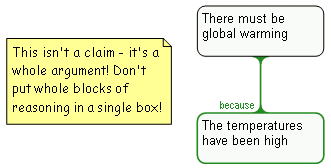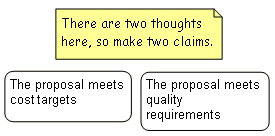The Science Of Scientific Writing Set 3 Set 3-Refining claims • Claims • Seven rules • Exercises 1-6 • Exercises 7-10 • Final Page Set 3.
OVERVIEW: The way to well-written science
PART I: Paragraphs and Sentences
SET A: Paragraphs: The Maps Behind Them
SET B: Paragraphs: Using Maps to Meet Readers' Expectations
SET C: Paragraphs with Something Extra: Points and Tails
SET D: The Generic Section: Expectations and Maps as Blueprints
SET E: Scientific Sections: The Methods and Results
SET F: Scientific Sections: The Discussion
SET G : Scientific Sections: The Introduction
SET H : Sentences
SET I : The Paper as a Whole
PART II: The Paper and its Sections
SET 1: Argument Parts
SET 2: Indicator Words
SET 4: Locating Arguments in Prose
SET 5: Rationale's Essay Planner
SET 6: Evidence in Arguments: Basis Boxes
Synthesis 1: Position-Early Paragraphs
Synthesis 2: Position-Final Paragraphs
Synthesis 3: Writing a Discussion I
Synthesis 4: Writing a Discussion II
So what goes in the boxes?

Seven rules:
1. No reasoning in a box (no ‘because’, ‘therefore’, ‘but’)
Example: 'The temperatures have been high therefore there must be global warming'

2. Only one thought per box (no ‘and’ or ‘neither’)
Example: 'The proposal meets cost targets and quality requirements'

3. Claims should be full sentences (no 'thought bites' or shortcuts)
Example: 'Lamb roast - Sunday lunch classic'

4. Claims should be capable of being true or false (no questions)
Example: 'Do the two leaders really believe that this demeaning behaviour is what the Australian voters want?'

5. Claims should be to the point (no waffle)
'Very very often sheltered people who are not in the know have expected to see chap-wearing, tobacco-chewing, dusty cowboys on the streets of Houston'

6. Claims should be easy to understand (no jargon, not convoluted)
Example: 'The strikes caused collateral damage among non-combatants'

7. Every box must make sense when read in isolation.
Example: 'Vegemite is healthy. It tastes good'

Content of this page drawn in whole or part from the Austhink Rationale Exercises with permission from Austhink.